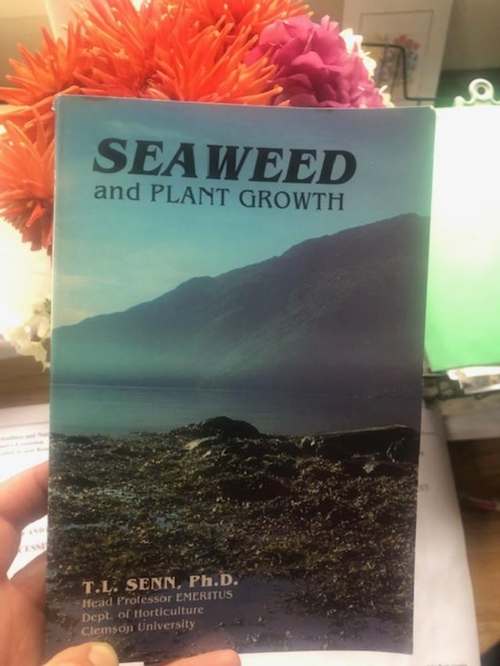Is the Juice Worth the Squeeze? Some Notes on the Utility of Seaweed Extracts in Berry Production on the Central Coast
Over the past year, I've had questions brought to me about the usefulness of seaweed extracts in the strawberries and caneberries of the Central Coast. Namely, are these extracts actually adding any benefit or value, and if so what precisely are they doing and how are they doing it?
It thus has been my good fortune to find in a colleague's library the book Seaweed and Plant Growth by Dr. T.L. Senn pictured below. While it was published a while ago, it nonetheless has provided me with a good foundation on the subject of seaweed extracts and their applicability to plant agriculture, a foundation upon which we can explore a bit about the possibilities these could offer berry growers on the Central Coast.
To begin, a lot of work has been done on the extracts of seaweed, in this case the marine alga Ascophyllum nodosum, which has been available to agriculture since at least the 1950's and is the main ingredient in many of the seaweed extracts on hand for growers on the Central Coast. Available as a soluble powder or liquid concentrate, these formulations contain a number of plant growth regulators, in particular cytokinins.
Cytokinins are hormones found in the rapidly dividing cells of plants, which generally are found in the tips of the roots and plant tips associated with bud initiation. The effects of these particular hormones, in concert with some of the other plant growth regulators found in the seaweed extracts are various, and I give a summary of them here:
Growth promotion, improved flower set and higher fruit yield: Since many of the plant hormones including the cytokinins are found in the actively growing points of the plant, it should not be surprising that certain studies have found increased rate of growth and inflorescence formation. For example, foliar application of seaweed extract in bananas resulted in faster shoot formation and heavier bunches; another study at the Connecticut Agricultural Research Station found significant increase in fruit spur formation in two varieties of apple following seaweed extract sprays when compared with unsprayed trees.
Looking to more recent literature in strawberries, a series of trials run over six years in Oxnard by a private research contractor showed that drip tape applications of an A. nodosum extract improved fruit yield by an average of 400 ten pound boxes per acre. This was attributed by the researcher to improvements in early plant growth and development, along with more tolerance to environmental stresses such as soil disease. These results from Oxnard were mirrored in a later study in strawberry in Australia.
Improved shelf life: The deterioration of fruit which takes place in storage is linked to an altered balance of hormones in the plant before harvest and the fruit once picked. The deterioration of fruit has in trials been delayed by the use of seaweed extracts, especially those with a lot of cytokinins like A. nodosum which apparently go some measure to restoring a more beneficial hormonal balance.
Results can be impressive, the book cites a remarkable trial in cucumbers where shelf life was improved by 14 to 21 days by treating the producing plants weekly with seaweed extracts; an increase of the shelf life in peaches was also realized following a similar program of regular application of extracts to bearing trees.
Micronutrient utilization: There is evidence given that the application of seaweed extract facilitates micronutrient uptake, either through chelation or improved plant metabolic activity, by plants. For example application of seaweed extract to tomatoes resulted in more manganese in the leaves of treated tomatoes than those of the untreated, and to levels beyond that of what was in the extract. Another study growing peppers with a mineral deficient fertilizer mix augmented with seaweed extract resulted in improved utilization of boron, copper, iron, zinc and manganese.
So, what do make of all of this? I think that while there are positive results, sometimes really eye opening results, cited here, we should consider the wide range of effects on an even wider range of commodities and also the cases where nothing happened at all. That many of these studies were run decades ago, but the use of seaweed extracts has yet to be widely adopted tells me that the effects are not always repeatable. This lack of consistency is not surprising to me, especially with hormones whose effects, unlike fertilizers or pesticides, are modulated by a wide range of factors and certainly don't function under a "more is better" paradigm.
It's complicated stuff here, and I think it would almost need to be pursued on a custom basis, farm to farm. The trials for what to do on each farm are not complicated to run, but one would have to commit to the work for several years to really figure out if they would make a positive contribution into the operation and worth putting into one's production program.

thumbnail
Comments:
But, as you know, when you write about something you end up learning a lot more about it, and so it is here. I think this theme of customization from farm to farm of these biologically derived or biologically active materials will go hand in hand with their increasing popularity and use. One size is not going to fit all with this stuff.


I appreciate your thoughtful discussion on this issue. Your conclusion is makes sense to me and could be applied to many novel products that marketed to growers.
Thank you, Eric
Posted by Eric Brennan on August 12, 2023 at 8:31 AM